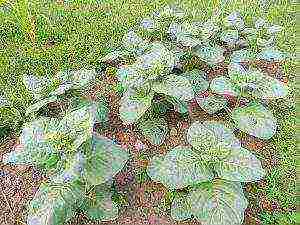Content [show]
It is not easy to choose the best varieties of asters for your summer cottage flower garden. Annual (Chinese) asters attract gardeners with a fabulous variety, and I want to plant the best varieties in the store. Modern varieties of the most beautiful asters were created by the best breeding schools and received worldwide recognition. Therefore, we consistently from year to year and grow the best representatives, selected from various varieties of asters.
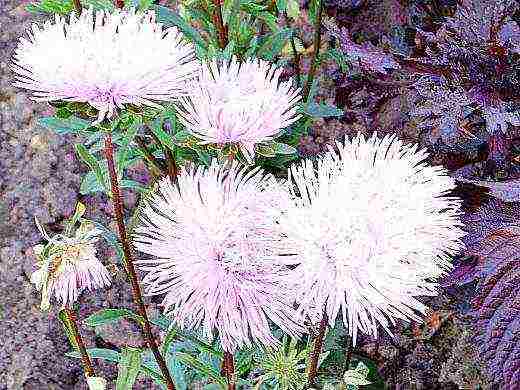
A rich assortment is set by the following parameters:
- Timing flowering (early, medium or medium late; long and fleeting).
- Branching and number of inflorescences.
- Height: ranges from 15 cm to 1 meter. In their own way decorative and border "kids", and cut "giants", and "middle group".
- The degree of doubleness of the corolla... Of course, thick double creations are in fashion, but semi-double "daisies" are also cute.
- Diameter: from 3 to 20 cm.
- The shape of the petals and inflorescences: needle, peony, pompom, etc.
- Coloration - the main "trump card" of the annual aster: a variety of bright or pastel colors, two-tone and complex overflows.
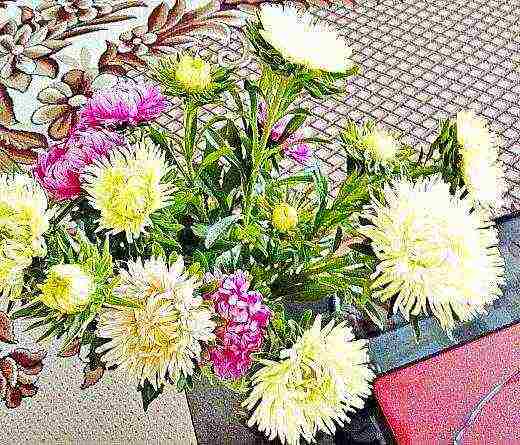
Asters do not require sowing too early. They are successfully cultivated through seedlings raised in outdoor greenhouses and unheated greenhouses. Winter crops are also practiced. Plants are unpretentious, and the only serious problem is their susceptibility to fusarium wilt (more about diseases and pests). There are modern varieties that are relatively resistant to this pathogen. Preventive measures can help you avoid trouble and help your true beauty emerge.
The best varieties of annual asters, with a description and photo
The best curb varieties of asters
Undersized
Flower bushes are not suitable for cutting, but they are indispensable in the design of a country garden.
Teise stars
The name plays up the original meaning of the Greek word ASTRA - "star". The novelty is a miracle of selection, unique in its short stature: the height of the whole plant does not exceed 15 cm. Miniature "balls" are densely covered with needle "stars" from the second month of summer until the end of the season (more than 100 days). The foliage is practically invisible. The diameter of each "star" is 6 cm, the shades are both rich and delicate. The beauty is resistant to bad weather, suitable for sowing before winter. Suitable for potting.
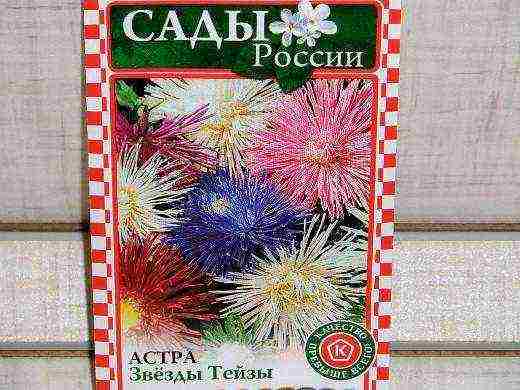
Erfurt dwarf
This kid is from Germany. The pyramidal, compact stem rises 20-30 cm above the ground. Strong twigs bear unexpectedly large inflorescences about 10 cm in size. They resemble miniature peonies - double and semi-double, saturated colors, in a classic color scheme. Bloom 3 months after the beginning of the growing season.
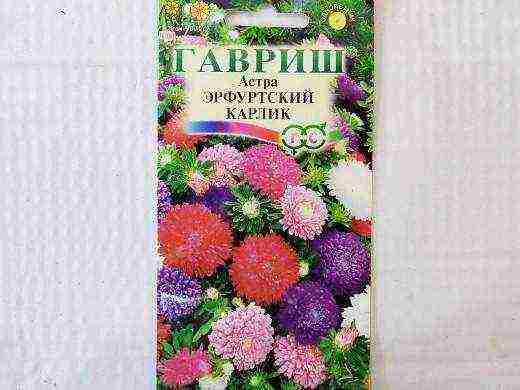
Varieties of the best tall asters for country flower beds and bouquets
There is no stable classification of asters according to the shape of the petals. For example, inflorescences with both narrow and wide petals can be attributed to the chrysanthemum type. But for a florist, it is not the name that is more important, but the real beauty.
Asters with wide petals
Basically, peony flowers of the classic type are presented here.
Duchess
Translated from French, the word means "duchess". This is a special type of peony aster with thick petals, beautifully inclined towards the center. Medium to mid-late flowering period: August-September. One branched stem can replace a whole bouquet. It grows 70-80 cm. Corollas are spherical, even, 9-10 cm each, with a rich palette of colors.

Mom's bouquet
Classic aster in the form of a peony with abundant flowering at the end of summer and early fall. Reaches a height of 70 cm. An erect, branchy bush is able to give a dozen flower heads with a diameter of 8-10 cm. They are great when cut - they do not wither for a long time in bouquets. The mixture gives out a varied color spectrum: bright colors prevail, but there are also delicate ones - light, pastel. Plants show the best qualities with high agricultural technology.

Tower
Peony type, wonderful in bouquets. Each stem of an individual flower grows by 35 cm or more, the common stem - by 70 cm. At the same time, more than a dozen baskets 8-10 cm in size can be observed in the dissolution. The palette of colors is the richest, at least a dozen shades: from saturated to pastel. One of the brightest is fiery red, and the most delicate is salmon.
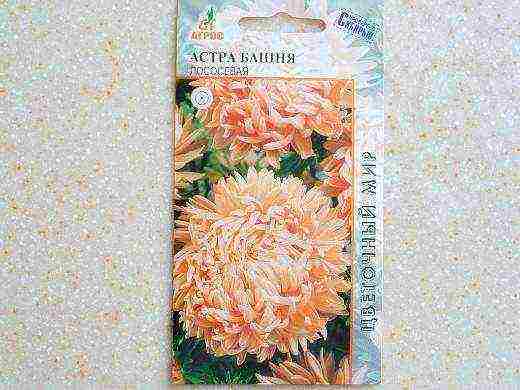

Royal peony
The largest variety of heads of all peony asters - 15 cm. The stems are strong, erect, up to 80 cm, columnar. Each plant produces a dozen extra-large corollas of the highest commercial quality. Strong petals don't suffer from rain. A powerful bush needs increased nutrition. Breeders offer 6 color options; the most saturated is the blue tone.
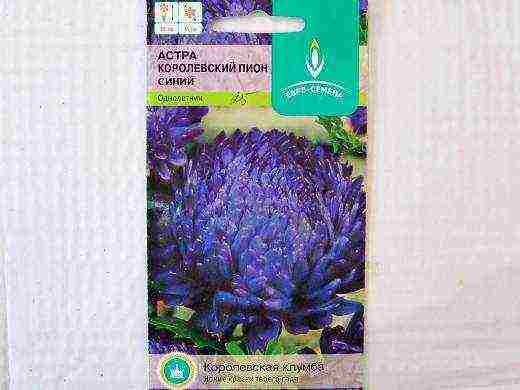
Alexandria
This mid-early variety is good for its versatility: strong trunks 0.7 m long are resistant to lodging in a flower bed, ideal in bouquets. Corollas resemble large chrysanthemums or peonies: hemispherical, 12-13 cm in size, very dense and even. Numerous strong inflorescences withstand the vagaries of bad weather well. Timely pruning activates new flowering waves. The variety exists in several tones: white, cream, pink, red, purple. The most original is chamoa: light salmon, pale pink with orange undertone.
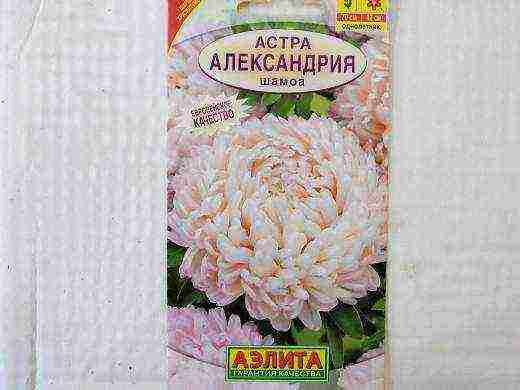
Yabluneva
The most popular aster variety, resistant to fusarium wilt. Sprawling bush, slightly above half a meter, bears up to a dozen corollas 10 cm in size. In shape, they resemble peonies - hemispherical, densely double. The plant attracts attention with its unusual color scheme (reminiscent of apple blossom). The bases of the petals are milky white, the tips are pale pink with a lilac-pink undertone, which intensifies as the corolla opens.
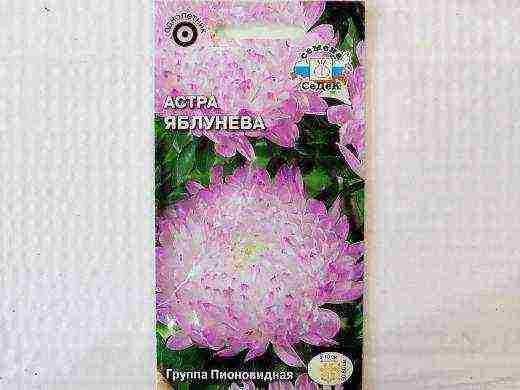
Gray-haired lady
This is a special pion-shaped aster with whitish-silvery ("gray") tips of the petals. The main tone is dark pink or lilac blue. The stems are strong, the heads do not droop, in full dissolution they are double or semi-double. The average size is 9 cm, the maximum is 12 cm. The bush is pyramidal, compressed, produces about a dozen flowering stems from July-August to autumn frosts.

Heart of France
The newest pion-shaped form of imported selection. Corolla diameter - 8 cm. The color is rich, blood-red; does not fade from sunlight, does not suffer from rain. Succulent spot in the flowerbed, excellent cut. The erect plant reaches a height of 70 cm, branches abundantly. Flowering period - mid-late: August-September.
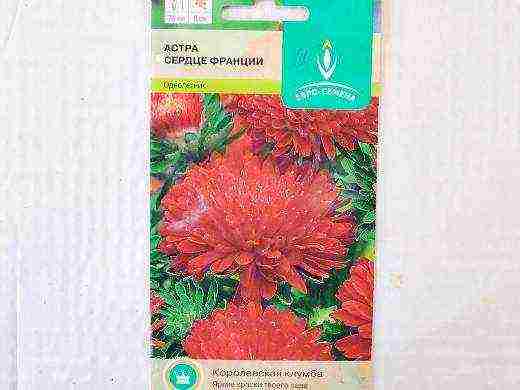
Antarctica
Peony aster of the rosy subtype, bush form. The flowers are not very large (6 cm), but they bloom in large numbers on a branched stem of half a meter growth. The width of the bush is half the height. The baskets are snow-white, very thick. This characteristic is applicable to the variety "Antarctica" from the companies "Gavrish" and "Artikul"; asters of the same name from the company "Sedek" - curb (height 25 cm, diameter 9 cm).
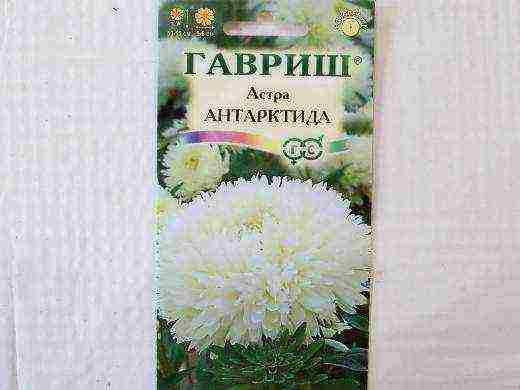
Asters with narrow petals
There are many varieties, and all of them are amazing, original, non-standard: for any, even the most demanding taste.
Needle
Unique
A popular variety of needle asters with a rich palette of colors and an exquisite scent. Flowering period is medium early to medium. Radiant "stars" reach a diameter of 13 cm. The central petals gracefully hide the center. Plants are tall (up to 0.7 meters), with numerous branches, require free placement. During the season, 5-10 standard bouquet stems can be cut from them. When sowing a mixture, there is no reliable guarantee of the appearance of a certain shade, therefore, separate packaging by color is popular among flower growers. Crystal-white "Snowflake" is always in demand.
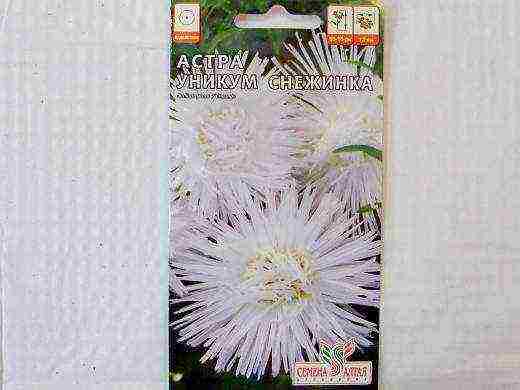
Comilfo
Translated from French: "what you need", "decent".
The perfect holiday cut. Coloring - snow-white. The sizes are record-breaking (16-17 cm). The heads are dense, with numerous petals - thin and graceful. The petals look very delicate, but in the ground they do not deteriorate from bad weather, and do not fade for a long time in the cut. Numerous peduncles sit firmly on a high stem (0.7 meters). A less common variant of red color (packaging of the company "Euro-seeds").
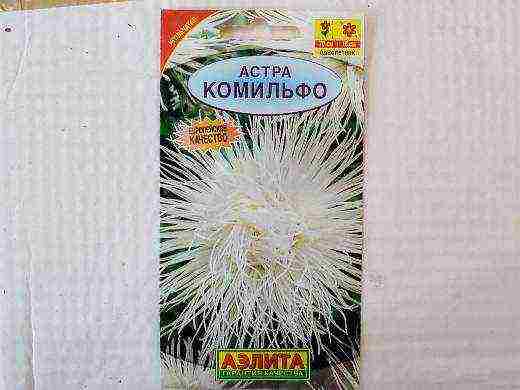
Harz
An unusually spectacular series with huge inflorescences - up to 16-18 cm in diameter. Thin needles-petals are arranged very densely, diverge in long beams, slightly curl in the center. Bushes start branching early, grow up to 70 cm. Powerful stems firmly hold standard, even-sized heads (9-11 pieces per root). Each of the many colors has its own name. Variety "Dutchman" - tender, salmon.
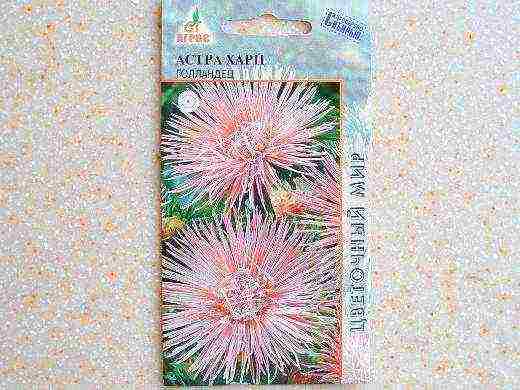
New
Updated format of the classic needle-like type with abundant mid-early flowering. The bushes are not too tall - half a meter, but the trunks are very strong: they do not bend under the weight of weighty "stars" 10-12 cm in size. Each plant produces at least a dozen buds. The color range of the new variety is very wide.

Claw
Needle petals are bizarrely bent by "claws" - usually towards the center, while slightly directed sideways in a spiral.
Gremlin
Bushes are upright, compressed; suitable for thickened planting (30 × 30 cm). Tall stems (75 cm) are capable of bearing 15-20 corollas with graceful petals rolled into narrow tubes. The petals are numerous, arranged very densely, evenly. The color scheme of the mixture is designed in bright colors, but sometimes pastels also slip through. The inflorescences surprise with the fact that they are even and beautiful in their own way, but at the same time unusual, and therefore not boring at all.
For reference: Gremlin is a "terrible" fairy-tale animal, a product of modern mythology (Great Britain, America, XX century).

Pavlova
The "terrible" is adjacent to the beautiful. In honor of the legendary Russian ballerina Anna Pavlova, not only a meringue cake and white tulips were named, but also new wonderful asters. About a dozen buds are formed on a slender plant. The inflorescence in dissolution resembles a spinning ballerina. The corolla is openwork - terry, but not too dense. The size when fully expanded is 10-12 cm. Plants are tall (0.7 meters), average flowering, 9-11 flowers on strong stems. There are various colors; among them, yellow has a moderate tonality close to lemon.
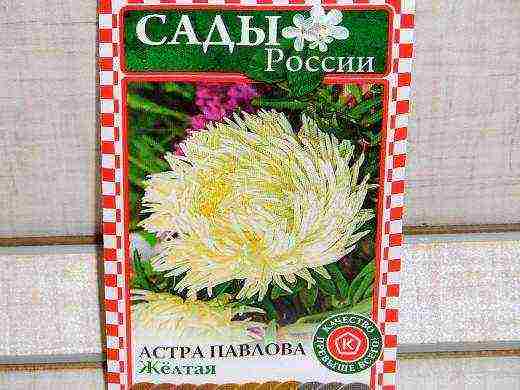
Chinchilla
Mid-early compact variety with a pyramidal bush: 0.7 meters high and 0.2 meters wide. Corollas bloom up to 12 cm in diameter, very dense and dense. Color - pink with salmon undertone. Chinchilla animals are indeed pinkish-beige in color, but the eponymous aster is still a little darker.
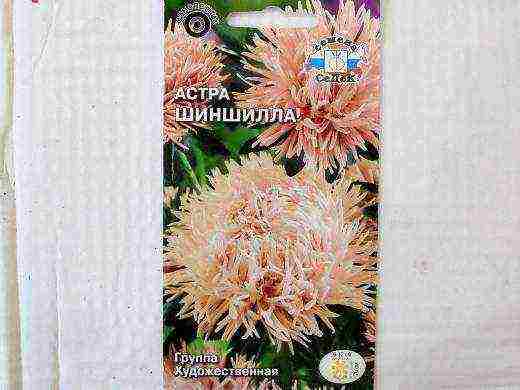
Krallen
Standard clawed aster of medium flowering period. It grows up to 75 cm, does not spread in breadth. The stems are not prone to breaking, strong and resilient. The flowers open up to 11-12 cm. The color scheme is designed in a variety of classic tones.
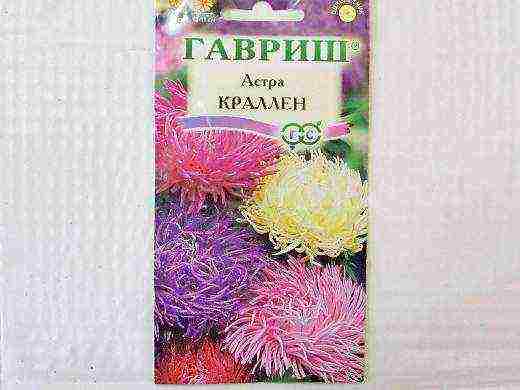
Needle-clawed
Javel
The modern cut series "Javel" (Jewel, Jewel) translates as "shine" and combines varieties of uniform shape with the names of jewelry stones (garnet, purpurite, ruby, heliodor, amethyst, rhodolite, etc.). Perhaps this is one of the most terry asters, with a huge number of narrow petals. They bloom in large balls 14 cm in diameter. At first, the petals stick out in even rays, then slightly bend with claws. The height of the bush is up to 0.7 meters. The bouquets are very durable.
Mineral heliodor is the most delicate golden-yellow variety of transparent beryl. Flower Javel Heliodor is a very light yellow, barely perceptible shade of butter. Coloring unique for the aster!
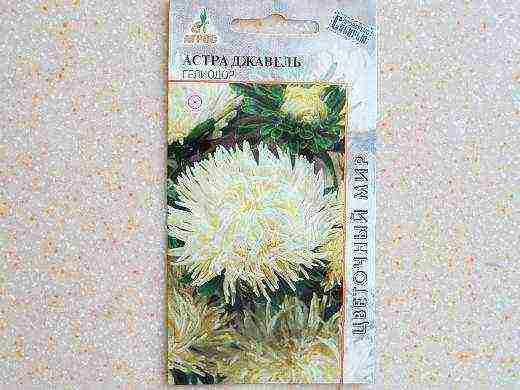
Spherical needle
This form is a relatively recent breeding novelty. Highly appreciated by professional cut flower growers.
Fairy
The variety combines early periods and long flowering, relatively hardy to fusarium wilt. The stem grows quickly to 65-70 cm, branches well, while maintaining the highest strength. During the season, more than a dozen buds are formed, which slowly bloom into large balls at least 12 cm in size. Needle petals are uniform in length and are extremely dense. The colors are very original - purple-crimson with a light sheen.
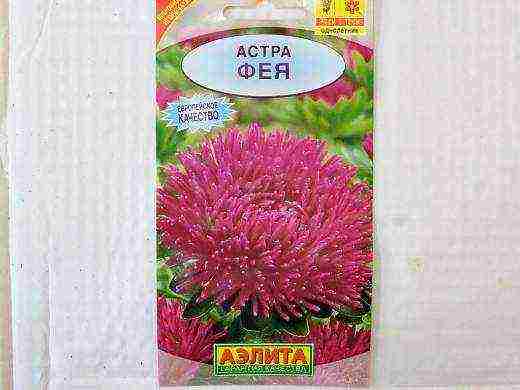
Cherry Eagle
This is the newest spherical needle type series, available in several varieties. Among them, aster "Cherry" ("cherry") stands out with a thick dark red color. A strong tall stem (0.7 meters) grows from 9 to 13 hemispherical flowers per season. Numerous petals are rolled into tubes and fit very tightly. Flowering begins in mid-summer and continues until frost.
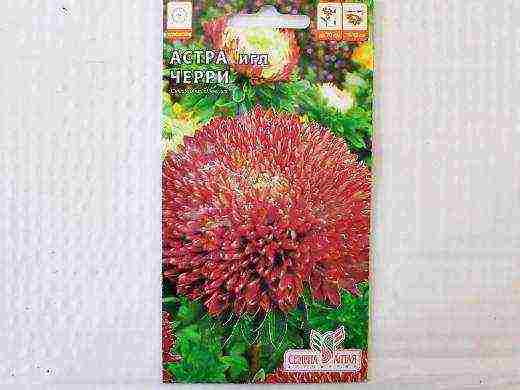
Pompom asters
These astrochis are not too tall and not very large, but there are a lot of corollas on the bush - up to fifty of them change over the entire season; a whole bouquet flaunts at the same time. Flowering pleases the eye for at least two months.
Pampushka
A special selection from the "Gavrish" company is endowed with original "edible" names: milk, strawberry, blueberry, etc. (more than a dozen varieties in total, according to the association of taste with color). Bushy stems rise half a meter from the ground. Corollas (5 cm in diameter) have an original shape. Extreme, slightly wider and longer petals form a kind of "skirt". The central petals are short, densely set. The varieties "Strawberry with Cream" and "Blueberry with Cream" are the most original: two-color, contrasting ones.
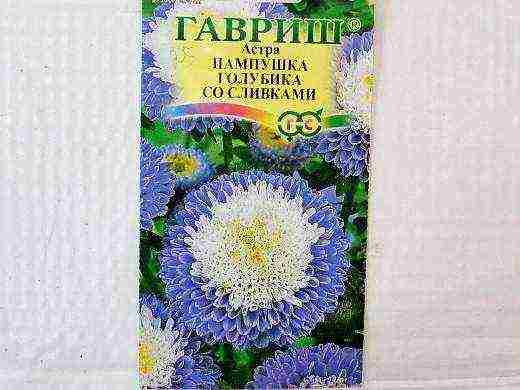
In this article you will find useful information about the most popular varieties of annual asters, as well as learn the classification of these garden flowers, which will help you make the right choice.
Classification of annual asters
Before proceeding with the description of the varieties of annual asters, let's talk about their classification. Knowing it, it will be easier for you to navigate in such a variety of varieties and species.
Today, there are about 40 groups of annual or garden asters (Callistephus chinensis) in culture, which include about four thousand varieties that differ from each other in bush size, color, inflorescence shape and flowering time.
Classification of asters by the height of the bush:
- dwarf (up to 25 cm) Pinocchio, Border, Olympiada, Monpassier;
- undersized (up to 35 cm) Milady, Scarlet, Lilliputian, Triumph;
- medium-sized (up to 60 cm); Victoria, Needle, Comet, Laplata, Pompom, Princess, Snow White, Daria, Eurasia
- tall (up to 80 cm); Peony, Princess, Pink, Art, Blue hoarfrost
- giant (above 80 cm);
Classification of asters by the structure of inflorescences:
- Tubular
- Transitional
- Reed. Moreover, the reed ones are divided into: non-terry simple, coronal, semi-double, curly, spherical, needle-like, tiled, hemispherical
Classification of asters according to the purpose of cultivation:
- cut-off (tall with large flowers on long peduncles);
- casing (compact and low, suitable for both flower beds and pots);
- universal (compact, medium-sized with large inflorescences).
The most popular varieties of annual asters
Bouquet aster A favorite of gardeners. Main advantages: unpretentiousness, medium height and abundant flowering. Cut flowers are a wonderful material for making bouquets, they do not fade for a long time. Most often grown in seedlings.
bouquet aster
Seeds of bouquet asters are sown in March-April, dive with the appearance of the first pair of true leaves according to the 5x5 cm scheme, seedlings are planted in open ground from mid-May to early June.
Bouquet aster varieties:
- Astra Bouquet white
- Astra Bouquet salmon-red.
- Astra Bouquet dark blue
Astra Bouquet, mix - Astra Bouquet red
- Astra Bouquet peach blossom
- Astra Bouquet yellow
- Astra Minuet Carmine
- Astra Minuet Light Yellow
- Astra Minuet Scarlet Red
- Astra Minuet, mix
Astra Duchess
This is a series of low-growing asters with large dense double flowers (height 25-35 cm, flower diameter 10 cm) - the best for container gardening, blooms profusely until frost-resistant.
astra duchess
Great for growing in containers, pots, balconies, flower beds, garden paths and borders. Most often grown in seedlings.
Varieties of Astra Duchesse:
- Astra Contrast
- Astra Comet, mix
- Astra Duchess, mix
- Astra Milady blue
- Astra Milady lilac
- Astra Milady pink
- Astra Milady red
- Astra Milady white
- Astra Milady, mix
- Astra Duchesse, improved blend
- Astra Duchess peach
- Astra Duchess ruby
Cutting aster
This tall variety of asters with small inflorescences (Height: 70 cm, Diameter: 5 cm) is attractive for gardeners because it has high resistance to diseases and adverse conditions, and is also famous for its long and abundant flowering (from July to September). Grown in seedlings.
Cutting aster
Varieties of bush-cut asters:
- Astra Duchess
- Astra Matsumoto
- Astra Russian size Pink Sonata
- Astra Matsumoto, mix
- Astra Matsumoto Defile, mix
- Astra Matsumoto Debut, mix
- Astra Gala, mix
- Astra American bush, mix
- Astra Bon-pari purple
- Astra Bon-pari pink
- Astra Bon-pari blue
- Astra Bon-pari, mix
Astra Needle
This variety of asters has tall (70 cm), wide, well-branched bushes, with large double (Ø11-13 cm) graceful inflorescences. Ideal for planting in prefabricated flower beds and on ridges - in rows and for cutting.
Aster needle
Flowers are cold-resistant, light-loving, do not tolerate stagnant water in the soil. They bloom from the second decade of August until frost. Cut flowers stay fresh in water for up to two weeks.
Most often grown in seedlings.
Varieties of needle aster:
- Astra Angiezhka
- Astra Openwork Placer
- Astra ANGORA
- Astra Anna Maria
- Astra Valentina, mix
- Astra Giant rays (different colors)
- Astra Goldstral
- Astra Juvel
- Astra Inga
- Astra Comilfo
- Aster cometo
- Astra Russian size
- Astra Unilux
- Astra Startlight
- Angelica
- Bonnita
- Gulliver
- Star scattering
- Coral reefs
- Russian size
- Russian vegetable garden
- Unique Violetta
- Astra harts Elsa
- Astra Charlotte
- Astra Chinchilla
Astra Peony
Distinctive features of this variety of asters: it is a powerful pyramidal bush 70 cm high, covered with densely double, hemispherical or spherical inflorescences (8-10 cm in diameter) Flowering - August-September. Most often grown in seedlings.
Pion-shaped aster
Varieties of peony asters:
- Zhanina
- Lapis lazuli
- Magdalena
- Nymph
- Opal
- Queen of the garden
- Scarlet Sails
- Versailles
- Variegated ribbon
- Diva
- King size
- Jessica
- Gray-haired lady
- Heart of France
- Snow Maiden
Astra pomponnaya
Distinctive features of this variety are very abundant early flowering with dense double flowers ..The flowers have a compact, strong bush up to 50 cm high, ideal in band and group plantings, cut into bouquets and planted in pots. Grown with seedlings.
Astra pomponnaya
Pompon aster varieties:
- Beatrice
- Superb Ruckley
- Pampushka (various colors)
- Blue Moon
- Gift of autumn
- Bolero
- Andromeda
- Aurora
- Duchess
- My whim
- Renaissance
- Russian size
- Margot
Aster pink
Distinctive features of this variety are, for the most part, tall flowers ((60-70 cm) with a pyramidal bush shape and numerous densely double pink-shaped inflorescences.
Aster pink
The main representative of the Grade of the Lady Coral series - The best series for professional cultivation for cutting, thanks to the large number of inflorescences on one plant, they retain their decorative effect for a long time in all weather conditions.
Most often grown in seedlings.
Claw aster
Distinctive features of this variety are small dense bushes up to 40 cm tall, with lush inflorescences with radiant petals and dense foliage from July. Ideal for flower beds and borders.
Claw aster
Claw aster varieties:
- Burma
- Jewel
- Cameo
- Chinchila
- Sorel
- Carmelita
- Jewel of various shades
- Fire king
Chrysanthemum aster
Distinctive features of this variety are large-flowered flowers with densely double inflorescences of bright colors .. The decorative value of the inflorescences is combined with compact bushes, up to 65 cm high, early, abundant and long flowering.
Chrysanthemum aster
Varieties:
- Ostrich feather
- Apollnonia mix
- Riben (paint mixtures)
- Ruby stars
- Peacock
- Tenderness
Astra corona
This is a variety of early flowering asters, with a pyramidal bush, up to 80 cm high. The inflorescences are double, dense, with a large number of long tubular petals. The variety is excellent for cutting, can be used to decorate flower beds.
Astra corona
Varieties:
- Sandra
- Kseniya
- Princess Diana
- Bouquet (different colors)
Aster Spherical - acicular and charavid - chrysanthemum - An unusually spectacular variety of asters with exceptionally graceful flowers.
Astra Spherical
The most popular varieties of annual asters according to gardeners' reviews
Below we give a brief description of some varieties of annual asters, tested over several years and highly appreciated by gardeners.
Popular tall varieties of annual asters:
- With needle inflorescences: Lingonberry red, Light red, White Nika, Blue frost, Nika, Night star, Marina, Blue-eyed, Smile
- With crown inflorescences: White ball, Galina, Katyusha, Lada, Cloud, Suleko, Morning Haze
- With hemispherical inflorescences: Snow White, Daria
- With spherical inflorescences: Zephyr, Eurasia, Bride, Youth
Popular undersized varieties of annual asters:
- With needle inflorescences: Vologda lace, Summer, Baby Border, Odarka, Oksana, Ruby stars
- With spherical and coronal: Pinocchio, Border, Olympiada, Monpassier;
We hope this information will help you decide which varieties of annual asters you want to grow in your garden.
Beautiful garden to you !!!
Save the article to your favorite social network so as not to lose:
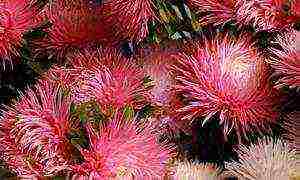 Asters are widespread in our gardens. These flowers are loved by most gardeners, so asters can be seen in a variety of varieties and shades. We offer you to familiarize yourself with the best varieties of asters, see photos of the most beautiful annual and perennial asters with a detailed description.
Asters are widespread in our gardens. These flowers are loved by most gardeners, so asters can be seen in a variety of varieties and shades. We offer you to familiarize yourself with the best varieties of asters, see photos of the most beautiful annual and perennial asters with a detailed description.
Aster flower: description
This culture is very popular with flower lovers. Translated from Greek, aster means "star". According to one of the legends, aster rose from stardust that fell from the sky... The Greeks believed that the flower brings good luck, so for them it was a kind of amulet. People tried to plant these flowers near a house or a temple.
Aster belongs to herbaceous perennial and annual plants of the Asteraceae or Asteraceae family.In nature, there are from 200 to 500 species of this flower. Most of them grows in Central and North America. Aster came to European countries from China.
The plant has simple leaves and inflorescences-baskets, which are collected in panicles or scutes. Depending on the variety flowers differ:
- coloring;
- the height of the bush;
- the shape of the leaves.
Basically this is a popular plant has needle-like flowers. Most often in our area, they are grown as annuals. Perennial varieties can also be found on sale. Any of the species has a beautiful and long flowering, good resistance to negative environmental conditions. They are drought-tolerant and light-loving plants. Almost all varieties shown in the photo have dense pedicels and beautiful inflorescences. Such characteristics of the flower are ideal for growing in the garden, creating landscaping.
Astra: the best perennial varieties
 Most of all, among perennial asters, varieties that bloom in autumn are valued. They truly decorate the autumn garden, which quietly fades before the onset of winter. Perennial varieties differ variety of colors, the height of the bushes. Among them there are dwarf varieties that often adorn alpine slides and rockeries.
Most of all, among perennial asters, varieties that bloom in autumn are valued. They truly decorate the autumn garden, which quietly fades before the onset of winter. Perennial varieties differ variety of colors, the height of the bushes. Among them there are dwarf varieties that often adorn alpine slides and rockeries.
The flowering period for perennials, as well as for annual asters, begins in May and ends in November. Bushes of a wide variety of shades decorate flower beds abundantly strewn with inflorescences. After planting perennial varieties, they will delight the eye for 5 years without requiring much maintenance. After this period of time, it is advisable to transplant the bush to another place. Among the perennial asters there are varieties:
- early flowering;
- summer;
- autumn.
Now we will take a closer look at each of them with a description, names and photos.
Early flowering asters the best varieties
These asters bloom from May to June. They can often be seen on alpine slides in group and single plantings. Most popular alpine aster, which, thanks to the efforts of breeders, was bred in many species. They differ in a large palette of shades, flowering period. Unpretentious in care, for which they are popular with flower lovers.
Albus is a low-growing aster of white color, the height of the bush is no more than 30 cm. Stems with a large number of leaves reach a height of 20 cm. White inflorescences are always clearly visible against the background of the flower bed.
Dunkle Scheen - different fluffy inflorescence in the form of daisies dark purple in color. The inflorescences reach 3 cm in diameter. They look good in the form of a composition with other flowers and as a frame for the foot of an alpine slide. The plant is frost-resistant.
Happy End - flowers of a pale pink color. They adorn straight and low, but strong stems. The bush grows up to 25 cm and blooms for almost a month.
Glory - inflorescences, camomile sky blue. The diameter of the flower is up to 4 cm, against the background of which the yellow center stands out brightly. Most often it is planted near conifers, as well as in combination with white and yellow flowers. Looks good in single fit too.
Goliath - blooms in June with large light purple inflorescences, up to 6 cm in diameter. Delicate inflorescences delight the eye for a month with their beauty. They are often planted on alpine slides.
Summer "stars" varieties
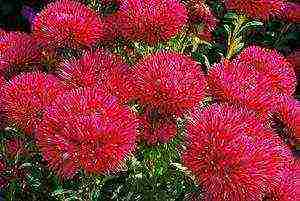 The average flowering period of the variety is distinguished by a higher growth. They reach a height of 30 to 70 cm. A bright representative of this group is the Italian aster. It is very often called chamomile. The height of the bushes allows you to plant it along the fence or as single bushes. Beautiful bright flowers are collected in shields, the diameter of which reaches 4 cm.Their color is distinguished by rich shades:
The average flowering period of the variety is distinguished by a higher growth. They reach a height of 30 to 70 cm. A bright representative of this group is the Italian aster. It is very often called chamomile. The height of the bushes allows you to plant it along the fence or as single bushes. Beautiful bright flowers are collected in shields, the diameter of which reaches 4 cm.Their color is distinguished by rich shades:
- blue;
- pink;
- light purple.
The flowering period of summer varieties begins in the month of June. They are often planted in rocky gardens and rockeries. To the most popular for planting asters include the following types.
Rosea - belongs to the longest flowering shrub asters.It begins to bloom in June and continues to delight the eye for three months. Medium-sized flowers with ligulate petals, have a pale pink tint. There are also tubulars of light brown color.
Lady Heindlip is one of the most popular varieties of prepresentatives of Italian asters. It has a rich pink color.
There is the Bessarabian aster, which is often also called falsely Italian. The bushes grow up to 75 cm in height with numerous dark purple flowers. Inside the flower there is a brown center.
Autumn varieties
 Late flowering includes several popular varieties - Shrub, New Belgian and New England. During this period of time, much more asters bloom.
Late flowering includes several popular varieties - Shrub, New Belgian and New England. During this period of time, much more asters bloom.
New Belgian asters can grow up to 1.5 meters. Shrubs have many branches with a lot of leaves. There are also almost glabrous stems with no deciduous mass. The color scheme is dominated by lilac-lilac shades, sometimes red and pink. The most common varieties look very beautiful in bouquets.
Amethyst blooms for about a month with dark purple semi-double flowers. On one stem, up to six flowers with ligulate petals.
Bellard is a great option for cutting in bouquets, as well as for planting in flower arrangements. Differs in lush color, therefore it is often used for single planting in flower beds. Flowers are medium-sized, bright pink in color.
Saturn - the bush reaches a height of one and a half meters. Lush blue inflorescences have a diameter of up to 4 cm and the flowering period lasts almost a month.
Perennial bush looks like compact but dense flowering bushes. They will grow up to half a meter in height. It blooms in early September and continues to give beauty until the onset of cold weather. The flowers are light purple or white. Most popular varieties planted as decorative deciduous plants. In addition to beautiful inflorescences, the bushes are distinguished by leafy stems. Some varieties do not have time to bloom due to climatic conditions in central Russia.
Blue Bird - his can be called dwarfas the height of the bush is only 25 cm. It is ideal for creating borders or a composition of low-growing plants as a central figure. The color can be sky blue and lilac shades.
Venus is also a dwarf bush up to 20 cm high. It is used as a hanging option to create floor pots and flower beds. Bloom later than all other varieties. The lilac-pink color of the inflorescences pleases with its beauty from September throughout the month.
New England asters unite at once a few main characteristics:
- strong bushes with straight stems;
- thick shoots;
- tall stems.
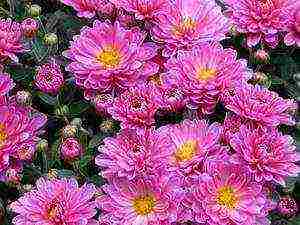 Brownman - the bush grows up to 1 meter in height and blooms in September. Lush inflorescences collected in lilac-violet brushes. The variety looks great in bouquets and flower beds. It is planted as a hedge.
Brownman - the bush grows up to 1 meter in height and blooms in September. Lush inflorescences collected in lilac-violet brushes. The variety looks great in bouquets and flower beds. It is planted as a hedge.
Dr. Ekenner - the height of the bushes reaches one and a half meters. This beautiful aster blooms with red-violet flowers, the diameter of which is 4 cm. The flowering period is almost 1 month, when all the flowers in the flowerbed have practically faded.
Rote Stern - is distinguished by large flowers of an unusual carmine shade. The height of the bush is up to one and a half meters, it blooms in the fall for 1 month.
Varieties of annual asters
The most popular variety of annuals is Chinese aster. The photo clearly shows the beauty of these vibrant colors. In the modern world, there are more than 600 species of this variety. All of them can be terry, semi-double and simple. In its form, this a variety of annual flowers can be:
- chrysonetemum;
- needle-like;
- spherical;
- pompom;
- pinkish;
- peony.
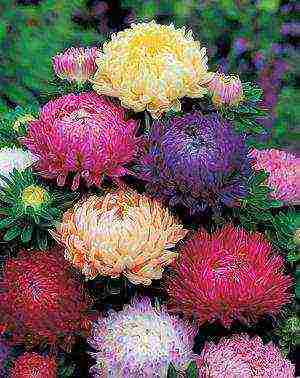 All varieties chinese asters look good as single bushes, and in the creation of compositions. Some of the most popular varieties of Chinese asters include:
All varieties chinese asters look good as single bushes, and in the creation of compositions. Some of the most popular varieties of Chinese asters include:
Galaxy - double needle-like inflorescences, 10 cm in diameter in various shades, the bush grows up to 70 cm;
Roseanne is a peony plant that can grow up to 65 cm. Pink flowers are distinguished by tightly pressed petals and curved in the middle;
Pomponnaya - has terry inflorescences of tubular elongated flowers. All these and many other varieties of annuals are easy to confuse with chrysanthemums or peonies, dahlias. You can figure it out only with the help of the classification of asters, but none of them is perfect.
Asters wide used in landscape design... They are always good for planting on a personal plot, flower beds of parks, decorating balconies, alpine slides. These flowers are always suitable for creating a bouquet.
Aster flower
Garden aster (Chinese) is an annual or biennial flowering plant, which is also called garden calistemma (Chinese) or Chinese callistephus (Latin Callistephus chinensis). The plant belongs to the class dicotyledonous, astrocyte order, aster family, genus Callistephus (Latin Callistephus). This genus is very close to the genus Astra (lat. Aster). Translated from Latin, the word "callistefus" means "beautiful wreath" - this is the name given to this flower by the French botanist Antoine Jussier in the middle of the 18th century, when he first saw the blossoming miracle on the flower bed of the Parisian botanical garden.
back to content ↑ Garden aster (Chinese) - description, characteristics, photo.
The root system of Chinese callistephus is fibrous and rather widely branched, mainly located at a depth of 15-20 cm. Damaged roots are very easily restored.
The erect and hard stems of the garden aster are green, sometimes reddish in color, usually very bushy, depending on the variety, reach a height of 20 to 100 centimeters. The stem of the plant is covered with short hairs, and longitudinal grooves can be seen on the surface of the stem.
The leaves of the garden aster are alternate, dark green in color, in some varieties the leaf blade is slightly pubescent. The leaves located in the lower third of the stem are larger. The length of the oval-rhombic leaf blade is from 3 to 7 cm with a width of 3 to 5 cm, the top of the leaf is pointed. In the upper part of the stem of callistephus, the leaves are smaller, with large denticles along the edge, oblong. Both the upper and lower leaves along the midrib and near the edge of the winged petiole, which is 3-7 cm long, are ciliate. The number of leaf plates on the main stem varies from 6 pieces to 19 pieces and depends on the variety.
The inflorescence of an annual Chinese aster is a basket consisting of numerous tubular and reed petals of the most varied colors and varying degrees of terry. In some varieties, the inflorescence reaches 18-20 cm in diameter, but aster varieties with a basket size of 3 to 11 cm are more common. The middle of the flower is almost always bright yellow. The basket is located singly, decorating the main stem and the tops of the lateral shoots. The outer part of the basket is protected by a wrapper formed by many oblong leaves (the outer ones are green, the inner ones are colorless, resembling a film).
The reed flowers of the garden aster are female, with three teeth at the top, can have a wide variety of colors and shapes: in the form of a spatula, ribbon, boat, tube or curl. In non-double varieties of callistephus, ligulate flowers are located along the edge of the basket in one row, in semi-double and double varieties - in several rows. Moreover, in double asters, tubular flowers are completely "hidden" under the reed ones.
The tubular flowers of the annual callistephus are located in the middle of the basket, forming a disc of various diameters. Usually they are small, painted in a bright yellow color, although in some varieties of garden asters they are quite large (up to 1 centimeter long) and can have a color identical to the reed ones. Tubular flowers are bisexual, their petals are fused.Both the tubular and ligulate flowers of the garden aster have a tuft of fine hairs in their structure, which help the seeds of the plant to spread self-seeding with the help of gusts of wind.
The callistefus fruit is an achene, which, depending on the cultivar group, can have different sizes and shapes. Most often it is tapered.
back to contents ↑ Where does Chinese callistephus grow?
The homeland of Chinese callistephus, of course, is China, but today garden aster is grown not only in Asian countries, but also in regions with colder climates, which became possible due to the painstaking work of breeders and thanks to the numerous varietal varieties that appeared as a result of their work. Chinese aster has become a favorite decoration of flower beds and lawns of Russian flower growers, it is cultivated in the Baltics and the Far East, Mongolia and Korea, it is quite widespread in Bulgaria and the Czech Republic, it feels good in Central America, but for some reason it is not very popular with local amateurs flower crops.
back to content ↑ Classification of asters and varieties.
Today in the world there are about 4000 varieties of garden asters, forming more than 40 variety groups. In addition, thanks to breeders, the number of newly bred varieties increases significantly every year.
For the convenience of classification, asters are distinguished by a number of characteristic features:
* among the varieties in the classifications, both annual and perennial asters are presented
by plant height:
- dwarf asters, rarely growing more than 25 cm in height (varieties Gnome, Glow, Snow pearls, Tanechkin bouquet, Triumph, Milady, Ballad, Granddaughter Anyutka, Granddaughter Katyusha, Granddaughter Mashenka, Granddaughter Nastenka, Little Queen, World of dreams, World of luxury, Music box, Field of Miracles, Rhythm of Life, Pinocchio);
- undersized astersthat do not exceed 35-40 cm in height (varieties Vologda lace, Summer, Baby curb, Autumn Olympics, Dwarf, Glow, Star pearls, Snow pearls, Talovchanka, Ribbon, Silver miracle, Feuerkugel, Dwarf royal bright pink);
- medium-sized astersgrowing no more than 65 cm in height (varieties Snow White, Daria, Dragon, Eurasia, Bride, Spectacular, Isadora, Alice, Assol, Belaya Nika, Blue Hoarfrost, Marina, Night Star, Naina, Smile, Jubilee white, White ball, Raspberry ball, Lada, Morning haze, Pampushka, Rita);
- tall astersreaching 80 cm in height (varieties Russian Beauty, Youth, Blue Frost, Katyusha, Nadezhda, Nata, Oblachko, Boretta, Violetter, Juvel, Quartz Tower, Changeable Blue, Krallen, Rose Crystal, Lady Coral, Madeleine, Royal Peony);
- giant astersgrowing in height by more than 80 cm (varieties Symphony, Royal, Slice, Apricot King, Apollonia, White King, Pink King, Matador, King size).
by the shape of the bush:
- pyramidal bushes (varieties of asters Night Star, Smile, Galina, Nata, Cloud, Suliko, Comilfo, Tourmaline, Queen in red, Queen in blue, Lilliput, Ambria);
- columnar bushes (aster varieties Snow White, Birch, Daria, Eurasia, Isadora, Assol, Belaya Nika, Marina, Blue hoarfrost, Naina, Sasha, Tanechkin bouquet, Timiryazevka, White ball, Katyusha, Katenka, Raspberry ball, Morning haze, Khavskaya silvery);
- oval bushes (varieties of asters Apollo, Waldersee, Sadness, Edelweiss, Snowball, Heart of a Beauty, Martian, Maxi, Pink Scattering, Ruddy Sun, Hawk Bouquet);
- wide spreading bushes;
- wide dense bushes.
by flowering time:
- early asterswhich begin to bloom in July. From germination to flowering, 83-106 days pass (varieties Salome Brick-red, Midi, Californian blue, Star of woodland, Carmen, Kirkvel, Summer night, Raspberry ball, Odarka, Polina, Roksolana, Ruby stars, Sofia, Sasha);
- medium asterswhose flowering period begins in early August.From germination to the beginning of flowering, 107-120 days pass (varieties Burma, Crimson, Blue Spider, Cloud, Heart of France, Samantha, Russian beauty);
- late asters with the beginning of mass flowering at the end of August. From germination to flowering, 121-131 days pass. (Varieties Tsaritsa, Anastasia, Gray Lady, Niobe, Venus, Oktoberfest, Elephant, Weiser, Violetta, Mount Everest, Beachwood Rivel, Herbert Wunder, Ada Ballard).
by the nature of branching:
- weakly branched;
- strongly branched.
by the structure of the bush:
- compact;
- spreading.
by the size of inflorescences:
- small asters (inflorescence diameter less than 4 cm) (varieties Apollo, Waldersee, Zarevo, Oktoberfest, Dick Ballard, Beachwood Rivel, Ada Ballard, Mary Ballard);
- medium asters (inflorescence diameter 8 cm) (varieties White Nika, White ball, Galina, Raspberry ball, Khavskaya silvery, Vologda lace, Oksana,);
- large asters (inflorescence diameter 9-11 cm) (varieties Snow White, Daria, Zephyr, Bride, Russian Beauty, Spectacular, Youth, Blue Frost, Marina, Naina, Night Star, Katyusha, Lada, Suliko);
- giant asters (inflorescence diameter over 12 cm) (varieties Isadora, Alice, Star of Woodland, Queen of the Market, Unicum, Smile, Bride, Sonnenshine, Comet, Flamingo, Californian gigantic, Californian blue, Tien Shan beauty, Harz carmezin, Aquamarine, Tatiana's day).
by the morphological structure of inflorescences:
- tubular varieties - plants with inflorescences composed of tubular flowers;
- transitional varieties with inflorescences consisting of tubular flowers that form the center, and ligulate flowers bordering it;
- reed varietiescharacterized by the complete absence of tubular flowers in the inflorescence or by the maximum development of reed flowers that visually cover the tubular center.
by destination:
- varieties for cutting (with a high stem, long peduncles and large inflorescences);
- decorative varieties (including a dwarf and undersized group with multiple small inflorescences. Used for the organization of flower beds, flower beds, rabatok, etc.);
- universal varieties (includes compact, medium-sized bushes with long peduncles and medium-sized inflorescences. They are suitable for both cutting and planting in flower beds).
by the shape of the inflorescences:
- flat asters (varieties Ada Ballard, Anmouth, Beachwood Ravel, Dick Ballard, Corallen Mittelblau, Medallion, Apollo, Waldersee, Sonnenkugel, Sonnenschein, Margarita, Salome Brick-ed);
- flat-round asters (varieties Aurora, Ambria, California blue, Riviera blue, Feuerkugel, Dwarf royal blue, Dwarf royal bright pink, Olympic gold, Excellent gasfort, Excellent rakley, Camilla, Victoria, Hohenpollern);
- hemispherical asters (varieties Bride, American Bush, Victoria Baum, Radiant Margarita, Early Miracle, Riviera, Triumph, Tubular, Schenheit, Duchess, Zarevo, Malyshka, Nadezhda, Oblachko, Galina, Vologda lace);
- spherical asters (varieties Martian, Fakel, Snow White, Daria, Zephyr, Russian Beauty, Youth, Oksana, Odarka, Eurasia, Blauer Turm, Opalfeuer, Roter Turm, Roter Berg, Duchesse Crimson, Duchess Carmia, Rosa Turm).
by the structure of inflorescences:
- simple asters (varieties Anemonoidnaya, Sonnenkugel, Sonnenshine, Margarita, Salome Brick-red, Pinocchio, Petito, Edelweiss, Salome, Andrella, Rainboy, Madeleine);
- semi-double asters (varieties Apollo, Anmut, Waldersee, Madeleine, Mignon, Cirrus, Rosette, Rose-Marie, Oktoberfest, Herbert Wunder, Violetta, White Waldersee, Matsumoto, Rosette);
- terry asters (varieties Golden bouquet, Mix of colors, Queen in blue, Queen in white, Royal ball, Heart of France, Elegy, Winter cherry, Olympic gold, Isolde, Bride, Victoria, Hohenpollern, Ruby stars, Tanechkin bouquet);
- thick double asters (varieties Comilfo, Assol, Koster, Milady, Yesenia, Night Star, Giant rays, Tatiana's day, Aquamarine, Tourmaline, Pearls, Queen of Market, Dolce Vita, Magic bouquet, Alla Borisovna, Galina Ulanova, Queen in pink, Queen in purple , Camilla, Elegy, Red Wine).
By color:
Despite the fact that there are a huge number of color options for garden asters, there is no classification for this parameter.Annual Chinese asters are white, red, pink, blue, purple, lilac, lilac, salmon, yellow, cream, carmine. There are also two-color asters (for example, varieties Rosa Turm, Rainbow, Contraster, Gray-haired lady). Only green and orange asters do not exist.
back to content ↑ Garden asters: species, varieties, photos and names.
When describing varieties in variety groups, a combination of all the above parameters is usually used. The most common among amateur flower growers are the following varieties of one-year and two-year asters:
- Laplata - a variety type of asters, bred by Danish breeders. This is a medium-sized cultivar group with a columnar form of a weakly branched bush. Stems are weakly leafy. On the bush there can be up to 16 blossoming terry drooping crown-shaped inflorescences at the same time, consisting of tubular and ligulate wide ribbon flowers. Aster flowers can reach 9 cm. This variety group belongs to the early and mid-flowering types and pleases with its beauty for 1.5-2 months. These asters are grown for cutting. The best varieties of asters:
- One-year aster "Oktyabrina" - a beautiful bush up to 45 cm high, with 9-11 inflorescences of dark carmine color, with one row of bordering reed flowers. The diameter of the inflorescences does not exceed 8 cm. The flower is not very susceptible to fusarium disease. These asters bloom in July.
- Aster annual "Laylek roses" - a plant with lilac-pink inflorescences located on a bush, 45-55 cm high. It blooms very early - in early July.
- Needle cultivar, which is a medium-sized and tall, little or medium-branched aster bushes of a columnar or pyramidal shape. On the bush there are usually up to 12 hemispherical double inflorescences, the diameter of which reaches 10 cm. The ligulate flowers, fused into a kind of hollow needle, form up to 7 bordering rows along the edge of the inflorescence. The outer rows are located horizontally, and the middle and central ones are directed "with a point" upwards. The middle, consisting of yellow tubular flowers, becomes visible only after the inflorescence is fully opened. Aster bloom, which begins in July or August, lasts about 50 days. Unfortunately, these flowers are susceptible to fusarium disease, and therefore require more careful care. The needle garden aster is suitable for universal use. Among all the variety, the following varieties of needle asters are popular:
- One-year aster "Lime" Is a medium to long flowering variety. The flowering period is about 50 days. The plant is 60 to 65 cm high, flowers are densely double, bright lilac in color, up to 12-14 cm in diameter.
- Aster annual Gala - a strong, stable bush of a pyramidal shape, up to 70-80 cm in height, with densely double inflorescences, the diameter of which can reach 12 cm. Aster flowering time is from early August to October. The color of the buds can be completely varied - from red and pink to beige and purple.
- Dwarf royal - a short, wide, spreading, strongly branched bush of asters, up to 30 cm in diameter. Strong shoots with dense foliage. Baskets of inflorescences are flat-rounded, full, double, up to 9 cm in size. The ligulate flowers are about 3 cm long and are somewhat bent outward, while superimposed on each other like tiles. Up to 30 inflorescences can bloom on the bush at the same time. Refers to mid-early varieties of garden asters with a flowering duration of up to 1.5 months. This Chinese aster is used as a decorative material for landscaping. The color of the buds can be white, pink, red, purple, carmine, blue. Beautiful varieties of asters:
- Aster annual "Glow"- a closed spherical bush up to 25-35 cm high with double inflorescences 4-5 cm in diameter, dark crimson in color.Asters bloom in late July, bloom profusely and for a rather long time - about 60 days. The variety is relatively resistant to fusarium infestation.
- Garden one-year aster "Feuerkugel" - a mid-early variety of asters with spherical bushes no more than 35 cm high and numerous inflorescences of rich red color, the diameter of which reaches 9 cm. The variety is not susceptible to fusarium.
- Pinkish the aster variety is medium-sized or tall bushes of a columnar or pyramidal shape, having up to 40 cm in girth. Shoots with a large amount of foliage can bear up to 19 double hemispherical inflorescences and a diameter of about 10 cm. The wide ligulate flowers are directed upward, giving the inflorescence a resemblance to a rose flower. The aster bloom period lasts about 2 months, starting in July. The plant is grown for cutting. The cultivar is weakly susceptible to fusarium infection. The best varieties of asters:
- Astra one-year-old "Snow White" - the bush is columnar, high, reaches 70 cm in height. Flowers are double or densely double, white, up to 12 cm in diameter. The variety has a long flowering time of 2 months. Average flowering time. The aster variety is resistant to fusarium, is used for cutting and for planting in flower beds.
- Aster one-year-old "Lady Coral" - a tall pyramidal bush with a large number of large pink double inflorescences. The buds have a diameter of 16-17 cm. The color of asters can be white, yellow, pink, red, cream, blue or purple. The variety has good resistance to fusarium. Grown for cutting.
- Pompom - is a medium-sized bushes with a pyramidal or columnar shape. The inflorescences of asters are lush, flat-round in shape, with a diameter of 4 to 8 cm. The bordering ligulate flowers are funnel-shaped or scaphoid in two or three rows. In this cultivar group, both types of flowers have a similar color, although there are varieties with a double or triple color. Asters bloom in July or early August and delight with their beauty for 2.5 months. They are used in decorative floriculture. The most beautiful asters:
- One-year aster "White Ball" - dense bushes about 40-45 cm high with many white inflorescences with a yellowish center, the size of which does not exceed 8 cm. Aster requires careful care, as it is strongly affected by fusarium.
- Astra one-year-old "Excellent Rakley" - a variety with a very effective appearance. A compact bush up to 0.5 m high with double flat-rounded inflorescences with a diameter of 4 to 8 cm. It has a two-color or tricolor color: bordering rather long ligulate flowers of a deep blue color, the central part is white. Sometimes tubular flowers with a clear yellow tint are visible in the middle.
- A princess - medium-sized or tall, wide, highly branched bushes. Flower-bearing shoots are strongly leafy. Up to 27 drooping large hemispherical inflorescences can bloom on one plant. Wide ligulate aster flowers border the middle in four rows. Inflorescences bloom in late July or early August. Aster flowering lasts about 2 months. Garden asters belonging to this variety are grown for cutting. Popular varieties:
- One-year aster "Cloud" - a semi-spreading bush about 70-75 cm high with densely double inflorescences up to 10 cm in diameter and hemispherical in shape. This variety is resistant to fusarium infection, tolerates bad weather conditions well. The variety is universal, therefore it is suitable for both flower beds and for cutting.
- One-year aster "Suliko" - a columnar bush up to 60-70 cm high is decorated with densely double flat-round inflorescences up to 10 cm in diameter, painted in a blue-violet shade. The flowering period is medium late. Duration of flowering is 60-70 days. The variety is resistant to fusarium and unfavorable weather conditions. A versatile variety, suitable for both cutting and growing in flower beds.
- Ostrich feather, which is a medium-sized and tall spreading bushes. On one plant, up to 22 double flat-rounded inflorescences can bloom at the same time. Reed flowers, resembling wide ribbons, are twisted into peculiar curls. The flowers form a lush crest, which visually overlaps the middle. Asters bloom in early August and delight with their beauty for at least two months. The variety is used for cutting. The best varieties of asters:
- One-year-old asterHel ruby mouth " - a plant 50-65 cm high with a spreading bush and bright ruby inflorescences up to 13 cm in diameter. Medium early in terms of flowering variety, practically not affected by Fusarium.
- One-year aster "White Ostrich Feather" - a variety with wide spreading bushes, the height of which does not exceed 0.65 m, and terry giant hemispherical inflorescences of snow-white color. A characteristic feature of the variety is the long reed flowers curled like female curls.
- Chrysanthemum - the variety type of asters is represented by tall shrubs of the columnar type. The flowering shoots are well leafy, with large semi-double or double inflorescences of a flat or hemispherical type. Up to 14 blossoming buds can often be observed on one bush. Wavy ligulate flowers look like wide ribbons twisted in length. Asters begin to bloom in early August. The variety is used both for cutting and for decorative purposes. Known varieties of asters:
- One-year aster "Apollonia" - neat bush up to 65 cm high, decorated with large densely double inflorescences up to 10 cm in diameter. Flowering is profuse and long lasting from mid-July to late September. The colors can be very diverse: from white and pink to red, blue and lilac. The plant is used both for cutting and for flower beds.
- Astra one-year-old "Nina" - a variety that forms compact bushes up to 50 cm high. About 37 simple chamomile-type inflorescences and bright red bloom on one plant. Weakly affected by Fusarium.
- Peony the variety is represented by wide, slightly branched, medium-sized bushes of a columnar type. Flowering shoots bear large, lush inflorescences that resemble a ball or hemisphere. Tightly adhering ligulate flowers of the scaphoid type, bordering the tubular center, are directed upwards. Up to 30 inflorescences can bloom on one bush at the same time and delight with their beauty for at least 2 months. The cultivar group belongs to the mid-flowering garden asters. They are used as an ornamental garden planting material, but can also be grown for cutting. Popular varieties of garden asters:
- Aster one-year "Gray Lady" - a compact bush no more than 0.65 m in height with large (9-10 cm) spherical inflorescences, painted in a pale purple color with a silvery sheen along the edges of the reed flowers. This variety of garden asters has good resistance to fusarium.
- Astra one-year "Quartz Tower" - a variety with very large and lush inflorescences with a diameter of 8-10 cm. The bush is columnar. It attracts flower growers with its original silvery color with dark pink tips of reed flowers. The height of the bushes does not exceed 65 cm. Suitable for both flower beds and cutting.
- Aster one-year "Gray Lady" - a compact bush no more than 0.65 m in height with large (9-10 cm) spherical inflorescences, painted in a pale purple color with a silvery sheen along the edges of the reed flowers. This variety of garden asters has good resistance to fusarium.
back to contents ↑ Asters: planting in the open ground and care. Aster seeds.
Garden aster propagates only by sowing seeds in open ground or by seedling. Regardless of the method of planting, aster seeds must be of good quality, so it is better to purchase them in specialized stores.
Seed preparation for planting.
In order for the seedlings to be strong and healthy, the planting material must be prepared in advance. There are several methods that give good results:
- Germination - a simple and effective method of activating the vitality of seeds.To do this, the aster seeds are wrapped in a soft cloth and abundantly moistened with a pale pink solution of potassium permanganate. To prevent the planting material from drying out, the bundle must be moistened with a spray bottle. A week later, the seeds, along with gauze, are placed in a plastic bag and taken to a room with a temperature of about + 22 ° C. After two to three days, you can plant aster seeds in the ground.
- Soak - a more accelerated method that allows you to plant seeds in seed containers after 10 hours. To do this, they are simply soaked in a pale pink solution of potassium permanganate or succinic acid. This measure will make the seeds more resistant to possible diseases.
Depending on the climatic conditions, it is necessary to grow aster seedlings from the last days of March to the second week of April. This makes it possible to admire the beautiful flowering inflorescences at the end of July.
back to contents ↑ Substratum.
As a substrate, it is advisable to use purchased soil with a high content of peat, after mixing a little coarse calcined sand with it. However, you can prepare the landing ground for asters yourself. To do this, mix ordinary soil taken in the garden, peat or humus with sand in a ratio of 3/1 / 0.5. After that, wood ash is added to the formed substrate and again thoroughly mixed. To disinfect the resulting soil and exclude the infection of aster seedlings with fungal diseases, it must be ignited in the oven for 1-2 hours or spilled with a hot solution of potassium permanganate of high concentration (dark cherry color).
back to contents ↑ Planting aster seeds for seedlings.
A planting box with a depth of about 7 cm or special cassettes are filled with a prepared substrate, which is abundantly moistened. After that, using a match or a toothpick, holes or grooves are made on its surface with a depth of no more than 0.5 cm, into which sprouted or soaked aster seeds are carefully placed. From above, the surface is sprinkled with a thin layer of fine peat or calcined sand.
To accelerate germination of seedlings and prevent rapid drying of the substrate, the containers are covered with plastic wrap or glass and taken to a room with a temperature of about 20-22 ° C. Periodically, the surface of the soil needs to be irrigated with a spray gun to maintain the necessary humidity inside the mini greenhouse.
In a maximum of 9 days, seedlings will appear, after which the covering material is removed, and the containers with seedlings are transferred to a cooler room with a temperature of + 15-17 ° C. As the substrate dries up, watering is carried out, avoiding waterlogging.
After the appearance of three real leaves on the seedlings of asters, the seedlings are dived. For this, you can use both special containers and small disposable cups. It is advisable to add a little universal fertilizer to the soil for dived seedlings and prepare the holes. The substrate in the container with the seedlings is preliminarily moistened in order to facilitate its removal and prevent damage to the roots.
A dived aster seedling is placed in the hole in such a way that the lower leaves are at a height of at least one centimeter from the surface of the substrate. The transplanted aster is watered, trying not to get on the leaves of the plant. The planted plants are placed in a bright and warm room with a temperature of no more than 20 ° C. If the room is lit by direct sunlight, arrange light shading so as not to cause sunburn on the leaves of the young plant.
back to contents ↑ Planting an aster in open ground.
There is no specific day when you need to plant asters in open ground. This usually occurs in the second decade of May, although this period may vary somewhat depending on weather and climatic conditions. The main thing is that night frosts on the soil should not be lower than -4оС.Another indicator of the readiness of aster seedlings is the presence of 5-6 leaves and a height of about 7 cm.
Aster seedlings are planted in open ground in the second half of the day, when the daytime activity of the sun is waning. It should be remembered that in order for the asters to feel comfortable and delight with their flowering for a long time, the soil on the site should be light, fertile, with an admixture of sandy loam or loam.
The preparation of the site for planting asters begins in the fall. To do this, together with digging the soil, humus and peat are introduced into it, and in the spring, superphosphate and potash fertilizers. The use of natural fertilizers in the form of fresh manure should be avoided, as it is possible to infect the soil with fungal diseases. It is advisable to treat the soil with fungicides as a preventive measure a week before planting young plants. In strongly acidic soils with a pH level below 6, carbon dioxide is added.
The holes prepared for aster seedlings are abundantly moistened and the plant is placed in them. The roots, sprinkled with earth, are tightly squeezed and covered with peat or dry humus. The planting depth of standard aster seedlings should be slightly deeper than in the container in which it was located. If the height of the seedlings exceeds 10 cm, it is deepened by 4-7 cm.Young asters are planted in open ground, adhering to the following rule: the distance between low-growing plants should be 20-25 cm, medium-sized plants - 25-30 cm, and between tall plants about 30- 40 cm.
back to contents ↑ Planting asters with seeds in the fall.
Sowing aster seeds in open ground can be carried out both in late autumn and in early spring, immediately after the snow melts. For the autumn planting of the garden aster, you need to prepare a place in October, before the onset of cold weather. For this, the soil for garden asters is deeply dug up and the rhizomes of perennial weeds are removed from it. The earth is plowed, leveled with a rake and lightly tamped. After that, several parallel grooves are made on it with a depth of no more than 2 cm with a distance of 25-30 cm and the plot is covered with an agricultural canvas. In November, with the onset of light frosts, the covering material is removed and seeds are poured into the prepared grooves, which are covered with dry fine earth or peat. The landing site is tamped and covered with a layer of fallen leaves or hay. The seeds of the garden aster, which have undergone natural stratification, give shoots that are often more viable than the shoots that emerged after the spring planting. In April, foliage or hay is removed, and the site is again covered with agrofibre, which protects emerging seedlings from possible frosts and provides them with the best microclimate. In early June, the covering material is removed, giving young plants complete freedom.
back to contents ↑ Planting asters with seeds in spring.
To minimize the influence of unpredictable weather, the spring planting of asters with seeds is carried out in two periods. The first is done in the last days of April, and the second in the first week of May. This doubles the chances of seeing flowering plants in your area.
On well-dug and slightly rammed earth, grooves are made up to a centimeter deep, which are watered abundantly before planting and allowed to be absorbed by water. Then the soaked aster seeds are placed in them with an interval of at least 1.5 cm. The furrows are covered with dry humus or peat, and the improvised beds themselves are covered with plastic wrap, keeping the optimum temperature and humidity under it. After friendly shoots appear, the film is removed. Aster sprouts removed during planting thinning can be used as additional planting material.
back to contents ↑ Caring for asters (callistephus).
The sprouts that have appeared or the planted seedlings of the garden aster need basic care, which includes:
- Watering aster, carried out as the soil dries, but not more than 20 l / m2.
- Loosening the soil around the bush after the water is completely absorbed. This allows oxygen to reach the roots.
- Top dressing asters, carried out in 3 stages:
- The first stage is carried out after the appearance of 4-5 pairs of leaves. To enhance the vegetation properties, ammonium nitrate is used at the rate of one matchbox per m2.
- The second feeding is done during the budding period of callistephus with superphosphate, nitrate and potassium salt, mixed in equal amounts. The fertilization dosage is the same.
- At the third stage, which occurs during the active flowering of the garden aster, phosphorus-potassium mixtures are used, the consumption of which is calculated at the rate of 30g / m2.
At any stage, instead of the above mixtures, you can use complex fertilizers for flowering plants purchased in special stores.
- An equally important step in caring for garden aster is pinching, expressed in the regulation of the growth of lateral shoots. On average, one aster should have no more than 3-5 stepsons to get large inflorescences; in medium-sized and tall plants, only one main stem is left. Pickling is carried out when the length of the side shoots reaches 3 cm. However, for most low-growing varieties, this operation is absolutely contraindicated, since it greatly reduces their decorative effect.
back to content ↑ Diseases and pests of the garden aster.
Unfortunately, Chinese callistephus is susceptible to some diseases that growers have to fight with:
- Fusarium... Waterlogging has a negative effect on garden aster. As a result of the fact that the root system ceases to receive the proper amount of air, the process of photosynthesis and the general growth of the plant stop. The swollen stem bursts and mycelium of fungi develops in the cracks that appear, leading to the development of fusarium. Usually this disease manifests itself during the formation of buds. The diseased plant is removed and burned. There are no effective drugs that can combat fusarium, but soaking the seeds before sowing in a solution of potassium permanganate or succinic acid significantly reduces the risk of infection. You should also not thicken the planting of flowers, as this interferes with the natural ventilation of the plants and can cause stagnation of moisture at the root collar.
- Septoriasis - a fungal disease that affects the leaves of callistephus, most often on the lower tiers. On the leaf blades, spots of light brown or brown color are formed, which then acquire a grayish tint. The leaves of the garden aster dry up, the plant loses its decorative effect and may die without timely help. At the first signs of septoria, the aster should be sprayed twice with one percent Bordeaux liquid or copper chloride (0.5%), observing an interval of a couple of weeks. It is not worth collecting seeds from diseased plants, since fungal spores remain on them.
- Gray rot affects garden aster in cold and excessively rainy summers. The disease is dangerous for all parts of the plant and has a detrimental effect on the leaves, stems and inflorescences of callistephus, causing their usual color to change to gray-brown. In addition, there is a rapid softening and decay of plant tissues with the formation of a gray fluffy coating on them. To combat gray rot on asters, they use Bordeaux liquid treatment, for prophylaxis use drugs such as "RidomilGold", "Fundazol" and "Tattu".
- Blackleg - a fungal disease of the garden aster, which causes decay of the root collar of the plant, most often affects seedlings and young seedlings. As a result, the main stem becomes thinner, the callistephus bush bends and breaks, which leads to the death of the aster. Good results in the fight against black leg are obtained by disinfection of the soil with a weak solution of manganese and copper sulfate, timely and as early as possible picking of seedlings.Dead bushes are necessarily burned.
- Jaundice of asters - a disease caused by a virus, but leafhoppers and aphids are the distributor of the disease. The leaves of the Chinese aster brighten along the veins, later yellowing or complete discoloration of the leaf blades occurs, the buds dry out, the aster bush slows down its growth. The main measures to combat aster jaundice are the elimination of disease vectors with drugs such as Aktelik or Inta-Vir, spraying plants with a solution of Pyrethrum, and burning heavily infected plants.
- Aphid helihrix - the pest affects the leaf plates of the aster, has a detrimental effect on the growth buds of young shoots and unblown inflorescences. Feeding on the juices of plant tissues, the aphid twists the leaves of Chinese callistephus, causes the buds to dry out and fall off, and significantly slows down the growth of the bush. As effective drugs for fighting aphids on asters, you can use agents such as karbofos or chlorophos. Spraying should be carried out as early as possible, before the appearance of the fifth or more true leaves.
- Spider mite - this pest usually settles on the underside of the leaf blade and begins to suck the juices out of it. The first sign of a spider mite affection of a garden annual aster is the appearance of tiny light dots on the leaves of the plant. Over time, they grow in size and merge into foci. Aster leaves acquire a marble color, curl, entwine with cobwebs and dry out. Due to a violation of photosynthesis in the plant, the buds begin to dry and crumble. To destroy the tick on the aster, drugs "Actellik", "Vertimek" or "Aktofit" are usually used, which do not cause the death of bees and other beneficial insects.
back to contents ↑ Interesting facts about the aster:
- The colors of garden asters are very versatile. There are no asters with only orange, green and pure black colors.
- Bouquets of Callistephus chinese, standing in vases, with regular water changes, retain their freshness for two weeks.
- In Hungary, the garden aster is considered a symbol of autumn, it is not for nothing that its name is translated from Hungarian as “the rose of autumn”.
- Aster was revered in ancient times. During excavations near Simferopol, a royal tomb was opened, which was more than 2000 years old. Among the numerous ornaments carved on the walls of the tomb, there was an image of this flower.
- Garden aster was able to grow at one of the Antarctic scientific stations. Thanks to the efforts of scientists, six bushes with inflorescences of a pale pink color have blossomed in a heated extension under a transparent two-layer dome with an air gap.
Did you like the article? Share with your friends:


